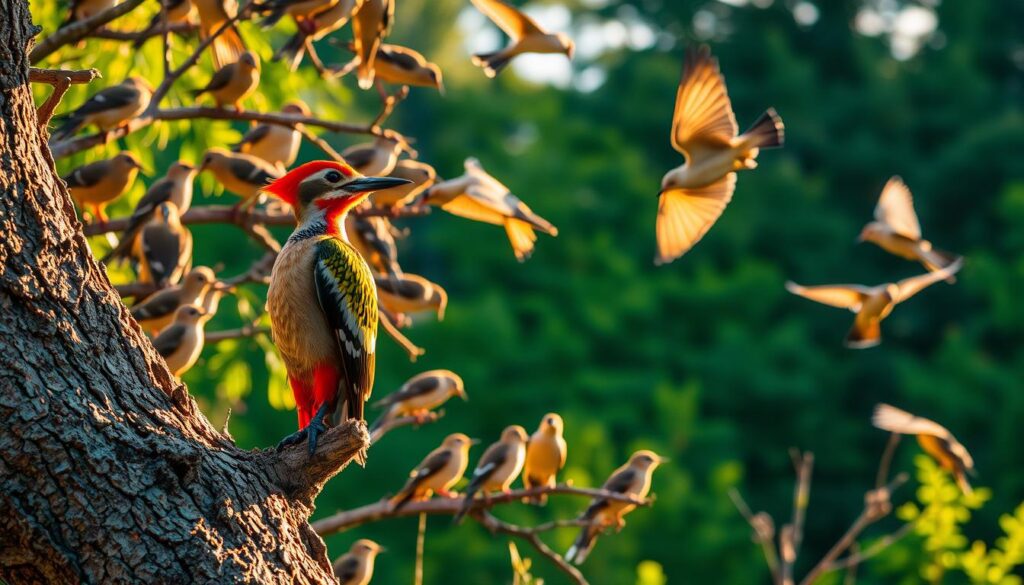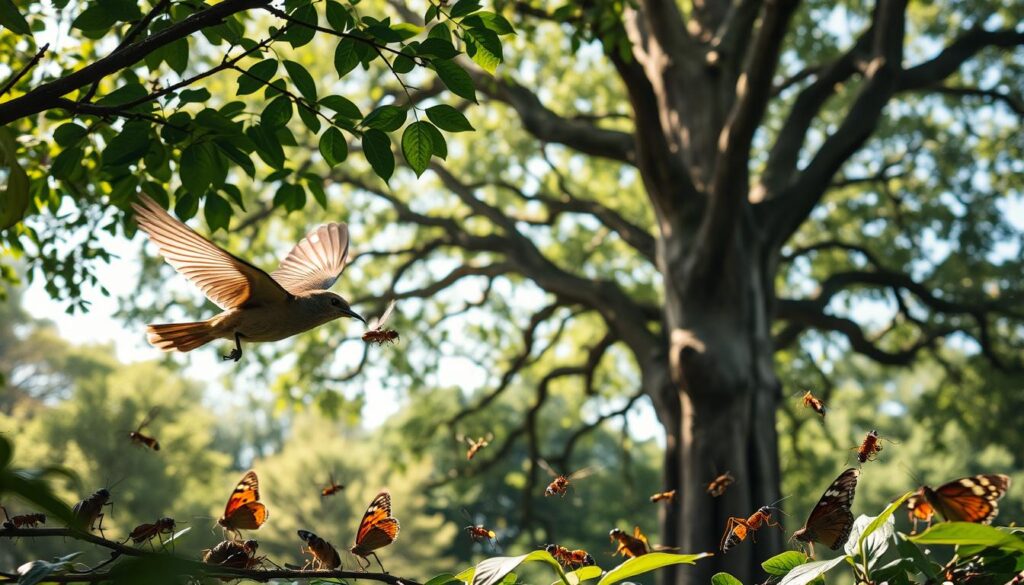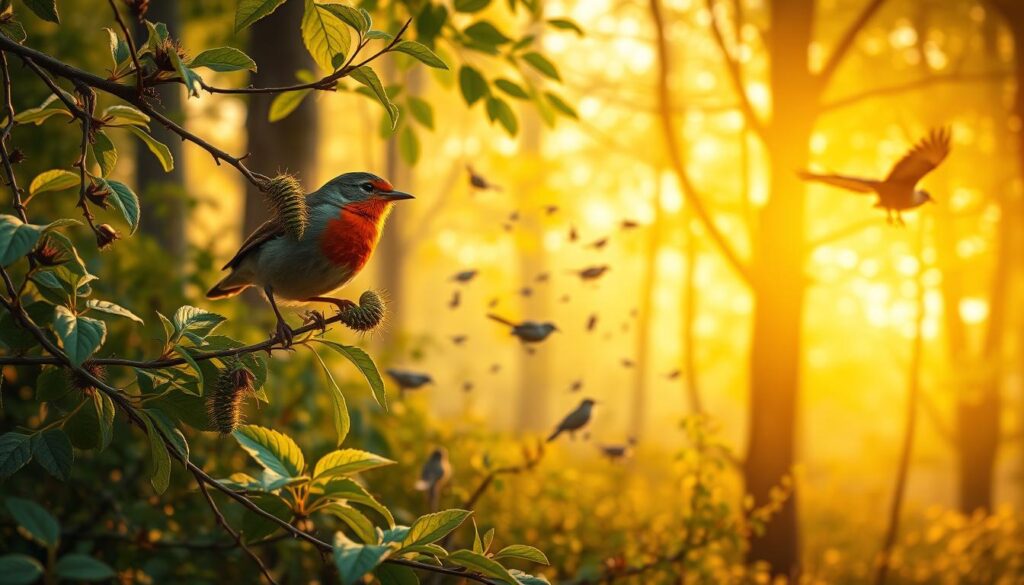North America is home to over 650 species of breeding birds. More than half of these migrate each year. They go to areas with lots of insects, like the 3,400-acre Silver Bluff Audubon Center. This shows how birds hunt insects by timing their trips right and knowing where to go.
Every spring, 500,000 Sandhill Cranes meet at Nebraska’s Platte River. They need insect-rich areas to fuel their long journeys. Birds like swallows and warblers have learned to hunt insects in clever ways over time.
Now, scientists use tiny geolocators to track birds like Swainson’s Warblers. These devices show their long journeys. It shows that birds don’t just hunt insects to survive. They also help shape the ecosystems around them. This article will dive into their battles against pests and why they’re important to us.
The Fascinating World of Avian Insect Predation
Insectivorous birds are vital in ecosystems around the world. More than 80% of bird families hunt insects. This makes them important in controlling pests naturally. We’ll look at why birds eat insects, their adaptations, and the benefits of this diet.
Why Birds Hunt Insects
Insects are a high-energy food source that birds need to survive. For many insectivorous birds, insects are their main food all year. During breeding, 96% of North American birds feed their chicks insects.
Chickadees, for example, need up to 570 caterpillars a day for each nest. This diet is rich in protein, helping chicks grow fast and supporting adult birds’ energy needs.
The Evolutionary Relationship Between Birds and Insects
For millions of years, bird species and insects have evolved together. Birds like purple martins fly fast to catch mosquitoes. Bee-eaters have special mouthparts to handle stinging insects.
Table 1 shows some bird species and their adaptations:
| Bird Species | Prey | Adaptation |
|---|---|---|
| Purple Martin | mosquitoes | High-speed flight |
| Bee-eater | bees/wasps | Handling venomous prey |
| Tree Swallow | large insects | Wide gape for nestlings |
Nutritional Benefits of Insect Consumption
Insects are full of protein, fats, and minerals. Caterpillars, for example, are rich in lipids, helping birds breed. Dragonflies give calcium for eggshells, and ants help keep feathers in good shape.
This diet is key for birds to survive and keep ecosystems balanced.
How Birds Hunts Insects: Techniques and Strategies
Predatory birds use many ways to catch insects. They adapt to different places and how insects behave. This helps them survive and keep the ecosystem in balance.
Aerial Hunting Methods
Swallows and swifts are great at catching insects in mid-air. Swainson’s hawks travel long distances to eat from swarms. American kestrels hover before diving to catch their prey.
Nighthawks have big, sticky mouths. They catch thousands of insects every night.
Ground Foraging Techniques
Thrushes and robins dig through leaf litter to find beetles or ants. Black-capped chickadees hang upside down to pick caterpillars off tree bark. They use their sharp eyes and feel to find hidden insects.
Ambush Predation Tactics
Herons stay very quiet in wetlands, then quickly grab their prey. Some flycatchers sit and wait, catching insects with their bristled bills. This way, they use less energy and catch more.
Specialized Adaptations for Insect Capture
Evolution has given birds special traits to help them hunt. Swifts have forked tails for better flying. Flycatchers have bill bristles to catch insects.
The Long-billed curlew has a curved beak to dig for larvae. Here’s a list of some key adaptations:
| Bird Species | Method | Adaptation |
|---|---|---|
| Swallow | Aerial hawking | Forked tail for speed control |
| Flycatcher | Perch hunting | Feathered bill bristles |
| Herons | Ambush | Extremely sharp, spear-like beaks |
| Swift | Airborne trapping | Specially adapted sticky saliva |
These special traits, along with changes with the seasons, help birds catch insects well. From forests to farms, their hunting ways show how nature keeps everything in balance.
Common Insectivorous Bird Species in North America
North America is home to many insectivorous birds that keep our ecosystems balanced. Birds like woodpeckers, nighthawks, and swallows eat over 400 million metric tons of insects every year. They are key in controlling pests in forests, grasslands, and cities.

The Common Nighthawk has seen an 80-90% drop in numbers, mainly due to lost habitats and pesticides. Swallows, like Barn and Tree Swallows, catch flying insects with their aerial stunts. Purple Martins are stable nationwide but decline in the Great Lakes area. Woodpeckers find beetles in tree bark, and flycatchers catch insects in mid-air.
Wisconsin is home to 19 aerial insectivore species. The Great Crested Flycatcher stands out with its reddish-brown and lemon-yellow colors.
- Swallows: 6 species in Wisconsin, including Tree Swallows that eat mosquitoes and gnats.
- Nightjars: Common Nighthawks and Chuck-will’s-widows hunt at dusk using large mouths to catch moths and beetles.
- Swifts: Chimney Swifts decline due to modern chimney designs unsuitable for nesting.
- Flycatchers: 10 breeding species in Wisconsin, using sit-and-wait tactics to catch insects.
Despite their importance, 73% of aerial insectivores are declining in numbers. Efforts to reduce neonicotinoid pesticides and restore habitats are underway. Protecting these bird species is essential for healthy ecosystems and natural pest control.
Specialized Anatomical Adaptations for Insect Hunting
Predatory birds have amazing physical traits for catching insects. These traits help them hunt better and choose what to eat. Features like beaks and vision are key to their survival.
Beak Shapes and Functions
- Flycatchers have broad, flat beaks to snap up flying insects midair.
- Warblers use slender, pointed bills to pry insects from leaves and bark.
- Woodpeckers’ chisel-like bills drill into trees to extract hidden insect larvae.
Vision Adaptations
Sharp eyesight is key. Many birds, like kestrels, see ultraviolet light off insects. Their big eyes can spot prey even when moving fast.

Foot and Claw Specializations
Zygodactyl feet help woodpeckers cling to trees. Swifts and swallows have long claws for perches. Barn owls have soft feathers for silent hunting.
These special features let birds rule their hunting grounds. They catch insects with amazing precision.
You May Like :- Captivating Guide to the Colorful Rainbow Lorikeet
Seasonal Variations in Bird Predation Patterns
Seasonal changes greatly affect how birds hunt insects. This shapes their feeding habits and survival strategies. In spring and summer, when insects are most abundant, birds forage more to feed their young.
During breeding season, birds like chimney swifts eat up to one-third of their body weight in flying insects. Timing is critical—many birds migrate with insect cycles to find food.
Spring and Summer Feeding Frenzies
Birds that eat insects hunt a lot during breeding. A single blue-gray gnatcatcher clutch needs hundreds of caterpillars every day. Studies show 8.3% of artificial larvae were eaten, most when young birds first fly.
Early in the season, larvae with warning colors were safer. But as birds got more experience, larvae that blended in better survived.
Migration and Insect Availability
- Common yellowthroats migrate to find insect-rich areas, matching their journey to insect hatching peaks.
- Arctic terns travel 55,000 miles a year, timing their flights for when insects are most plentiful.
- Wintering birds like wood storks eat more aquatic insects when flying insects are scarce.
Winter Foraging Challenges
In winter, when flying insects are scarce, birds find new ways to eat. Chickadees start eating insects from tree bark. Some birds, like nuthatches, eat more berries when insects are hard to find.
Studies show that mid-summer, when young birds get better at hunting, survival rates for certain larvae increase. This is based on research of 688 Lepidopteran species.
Birds as Natural Pest Control Agents
Wild birds are key players in natural pest control, helping us avoid chemical pesticides. They eat up to 500 million tons of insects every year. This protects our crops and the environment. For example, Western Bluebirds help vineyards by eating beetles and caterpillars.

Studies show that olive orchards with birds have 65-71% fewer pests. Birds like bluebirds also clean up mummified fruit, making post-harvest work easier. The Wild Farm Alliance supports these efforts by encouraging habitat-friendly farming.
| Bluebird Nest Box Guidelines |
|---|
| Entrance hole: 1.5″ diameter |
| Interior dimensions: 5.5″ x 5.5″ cavity |
| Placement: 5′ above ground, 200-300 yards apart |
Here are some practical steps for farmers:
- Plant native hedgerows to attract beneficial species
- Provide year-round water sources
- Remove invasive species to preserve native habitats
Bluebirds eat 5-8 grams of insects daily during nesting seasons. That’s over 2,000 pests per bird each year. Sustainable farming practices like these can reduce crop loss from 40% to just a few percent. This helps preserve biodiversity and increases yields.
By making farms bird-friendly, we use fewer chemicals and improve soil health. Bird droppings help the soil. But, we need to watch out for birds like blackbirds to avoid them eating too much during non-breeding seasons. Finding the right balance helps control insects without harming the environment.
The Ecological Impact of Insectivorous Birds
Insect predators like birds are key to keeping ecosystems balanced. They eat insects, stopping them from becoming pests. This helps protect forests and crops. Birds eat 400 million metric tons of insects every year, which is a big deal for our planet.
This eating habit changes how insects behave. It makes them better at hiding and staying active at night. This is because birds are always on the lookout for their next meal.
Forests and farms need birds to keep pests under control. In tropical areas, 60% of bird species live all year round. They eat insects constantly. For example, neotropical forests have 2,081 bird species that help control pests.
In farms, birds help save crops from damage. This saves farmers a lot of money every year. Without birds, pests could take over, causing huge problems.
| Biome | Bird Density | Biomass (million kg) |
|---|---|---|
| Tropical Forests | 20/ha | 1,120 |
| Temperate Forests | 10/ha | 651 |
| Croplands | 3/ha | 154 |

Over time, birds’ hunting habits change how insects evolve. Insects grow thicker shells or change when they fly. But, losing their homes and using pesticides harms these birds.
Keeping bird habitats safe is important. It helps ecosystems stay healthy. Without birds, nature and farming would face big challenges.
How to Observe Bird Hunting Behavior in Your Backyard
Make your yard a place to watch birds by creating a welcoming space. Bird watching is all about seeing how Cedar Waxwings and Pine Warblers live. They like safe spots, thick bushes, and places full of insects.
Creating a Bird-Friendly Habitat
Plant native trees like serviceberry and shrubs like viburnum to attract insects. These plants also offer cover. A birdbath or small pond will draw birds like Northern Harriers, which hunt over open fields.
Don’t use pesticides. They harm the insects that birds need to survive. Watch how Pine Warblers and Acadian Flycatchers hunt in different ways. This shows how each bird is unique.
Best Times for Observation
-
- Dawn and dusk: See swallows catching insects in the air at sunrise.
- Crepuscular hours
: Northern Harriers fly low over fields at twilight, using their long tails for precision.
-
- Summer evenings
: Listen for Cedar Waxwings gathering in shrubs before nightfall.
Equipment for Bird Watching
Binoculars with 8x magnification help you see details like a Sharp-shinned Hawk’s short wings. Use a field guide to learn about birds like the Acadian Flycatcher. A compact camera is great for capturing their behavior, like the Northern Harrier’s hovering hunts.

Remember, patience is important. Sit quietly at eye level with the plants to avoid scaring the birds away.
Climate Change and Its Effects on Bird-Insect Relationships
Rising global temperatures are changing the balance between insects and their predators. Ecological impact studies show that birds and insects are no longer in sync. Birds migrate to North America when insects are most abundant. But warmer springs mess up this timing.
A 2011 study found species moving habitats at 36 feet per decade. They struggle to adapt fast enough.
- Phenological mismatches: Earlier insect hatches leave many insect predators arriving too late to feed chicks.
- Insect declines: A 2020 report notes a 9% annual loss in terrestrial insect biomass, reducing food for birds.
- Habitat shifts: Warmer regions force species like Atlantic puffins to travel farther for food, lowering chick survival rates.
Extreme weather makes things worse. Droughts shrink wetlands, while floods destroy nests. Birds in agricultural areas see a 50% drop in nesting success during heatwaves, a 2020 analysis of 152,000 nests shows.
Forest and urban areas with trees offer better protection against heat. They help keep temperatures down.
Conservation efforts need to tackle these ecological impact changes. Protecting migratory paths and restoring habitats could help. The CMS report calls for quick action, as 9% of insects disappear yearly.
This threatens entire ecosystems. Without matching conservation policies and climate science, these species could decline irreversibly.
Conservation Challenges for Insectivorous Bird Species
Insectivorous birds are facing big challenges. Their homes are getting smaller and food is harder to find. Over 40% of migratory birds are losing numbers, with some like Bachman’s Warbler possibly gone forever. This is because of lost habitats and changes made by humans.
Habitat Loss Impacts
Deforestation and cities spreading out are destroying forests and wetlands. These places are where birds find food and make homes. When forests get broken up, birds can’t migrate well and find fewer insects.
Agriculture is also a problem. It turns diverse lands into single crops. This takes away the homes of many bird species.

Pesticide Use and Bird Health
Pesticides, like neonicotinoids, harm birds and reduce insects they eat. Research shows these chemicals can make bird populations smaller. Insects are disappearing at a rate of 9% each year, making it harder for birds to find food.
Conservation Success Stories
- In Costa Rica, farming in a better way helped birds by increasing insects.
- In Mexico, planting trees helped birds like Swainson’s Thrush find homes.
- International agreements protect 1,924 bird species, helping them in their migrations.
People helping out through apps like eBird are making a difference. Simple actions like planting native plants and using fewer pesticides can help. Saving insectivorous birds is key to keeping ecosystems healthy and balanced.
Conclusion: The Vital Role of Insect-Hunting Birds in Our Ecosystem
Insectivorous birds play a key role in our ecosystems. They help control pests, protecting crops and biodiversity. By eating insects, they prevent damage to crops and stop diseases from spreading. This saves farmers a lot of money every year.
Barn Swallows, for example, can eat up to 60 insects in just one hour. This helps a lot with controlling insects. Around the world, birds eat 400–500 million metric tons of insects every year. This is very important for keeping forests and farmlands healthy.
But these birds are facing big threats. Habitat loss and pesticides are harming their numbers. It’s important to protect their homes and reduce the use of harmful chemicals. Conservation efforts, like fixing damaged habitats, have helped some bird populations grow again.
Without these birds, our ecosystems would suffer. Places where vulture numbers have dropped have seen more carcasses and disease risks. This shows how important birds are to our environment.
What we do matters. We can help by planting native plants, avoiding pesticides, and keeping green areas. Joining citizen science projects can also help track bird populations. By valuing their role, we protect not just birds but the whole web of life they support.
FAQ
What types of birds are considered insectivorous?
Birds like swallows, flycatchers, woodpeckers, and warblers are insectivorous. They have special ways to hunt and eat insects.
How do birds capture insects while in flight?
Birds like swallows catch insects in mid-air. They use their quick moves and timing to do this.
Why are insects such an important part of a bird’s diet?
Insects give birds the protein, fats, and nutrients they need. This is very important, like during breeding seasons when they need lots of energy.
How do seasonal changes affect bird predation patterns?
In spring and summer, birds hunt more insects because of breeding. Migration also matches when insects are plentiful.
What role do insectivorous birds play in natural pest control?
These birds keep insect numbers in check. This helps plants and prevents damage, acting as a natural pest control.
How can I create a bird-friendly habitat in my backyard?
To attract birds, plant native plants that insects like. Also, have water sources and avoid using pesticides. This helps insects and birds.
What are some adaptations that make birds effective insect hunters?
Birds have special beaks, great eyesight, and unique feet. These help them hunt and catch insects.
How does climate change impact bird-insect relationships?
Climate change messes up when insects come out. This can make it hard for birds to find food when they need it most.
What conservation challenges do insectivorous birds face?
These birds face threats like losing their homes, pesticides harming them, and climate change affecting their food and breeding.
How can individuals contribute to bird conservation?
You can help by keeping bird-friendly areas, joining citizen science projects, and supporting farming that protects insects and birds.


